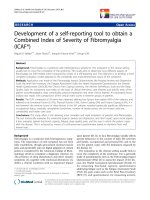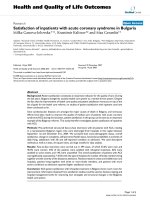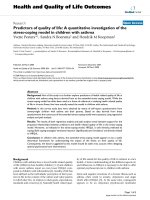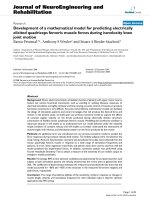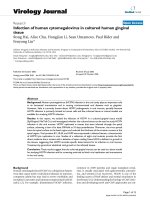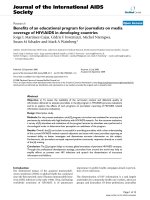Báo cáo hóa học: " Investigation of Semiconductor Quantum Dots for Waveguide Electroabsorption Modula" docx
Bạn đang xem bản rút gọn của tài liệu. Xem và tải ngay bản đầy đủ của tài liệu tại đây (317 KB, 5 trang )
NANO EXPRESS
Investigation of Semiconductor Quantum Dots for Waveguide
Electroabsorption Modulator
C. Y. Ngo Æ S. F. Yoon Æ W. K. Loke Æ Q. Cao Æ
D. R. Lim Æ Vincent Wong Æ Y. K. Sim Æ S. J. Chua
Received: 27 July 2008 / Accepted: 2 October 2008 /Published online: 21 October 2008
Ó to the authors 2008
Abstract In this work, we investigated the use of 10-layer
InAs quantum dot (QD) as active region of an electroab-
sorption modulator (EAM). The QD-EAM is a p-i-n ridge
waveguide structure with intrinsic layer thickness of 0.4 lm,
width of 10 lm, and length of 1.0 mm. Photocurrent mea-
surement reveals a Stark shift of *5 meV (*7 nm) at
reverse bias of 3 V (75 kV/cm) and broadening of the res-
onance peak due to field ionization of electrons and holes
was observed for E-field larger than 25 kV/cm. Investiga-
tion at wavelength range of 1,300–1320 nm reveals that the
largest absorption change occurs at 1317 nm. Optical
transmission measurement at this wavelength shows inser-
tion loss of *8 dB, and extinction ratio of *5 dB at reverse
bias of 5 V. Consequently, methods to improve the perfor-
mance of the QD-EAM are proposed. We believe that QDs
are promising for EAM and the performance of QD-EAM
will improve with increasing research efforts.
Keywords InAs quantum dots Á Electroabsorption
modulator Á Ridge waveguide structure Á Photocurrent Á
Optical transmission
Introduction
Semiconductor quantum dots (QDs) is attracting tremen-
dous research interests due to the benefits promised by the
three-dimensional (3D) carrier confinement of the QD
system. For example, the 3D carrier confinement provides
QD lasers the possibilities to achieve low threshold current
density and high differential gain. Consequently, high
power, efficiency, and temperature insensitivity have been
reported [1–3]. Furthermore, the optical properties and
surface morphology of the QDs can be tuned by altering
the growth process [4, 5], rendering this material system
suitable for many photonic devices. However, while vast
efforts have been channeled to investigate QD photonic
devices in optical fiber communication systems, existing
research efforts mainly focus on the potential of QDs for
transmitters [6–8] and amplifiers [9].
In fact, the 3D carrier confinement of the QDs also
results in stronger Coulombic interaction and oscillator
strength of the electron-hole pairs as compared to the
higher dimensional systems, e.g. quantum wells (QWs)
[10]. This property is attractive for electroabsorption
modulators (EAMs) utilizing the QD systems since it the-
oretically implies higher efficiency as compared to the QW
counterparts, i.e. larger extinction ratio (ER) for a given
external electric field (F
ext
) or lower F
ext
for a given ER
[11]. However, to date, there are little research efforts on
the investigation of QDs for EAMs. Furthermore, most of
the existing works discuss either the quantum confined
Stark effect (QCSE) [12, 13] or carriers dynamics [12, 14]
of QDs under reverse bias.
Motivated by the abovementioned possibility of
achieving EAMs with higher efficiency, we investigate the
potential of employing semiconductor QDs as the active
region for EAMs. In this work, we will report on the
C. Y. Ngo (&) Á S. F. Yoon Á W. K. Loke Á Q. Cao Á D. R. Lim
School of Electrical and Electronic Engineering,
Nanyang Technological University, 50 Nanyang Avenue,
Singapore 639798, Singapore
e-mail:
V. Wong Á Y. K. Sim
Temasek Laboratories @ NTU, Nanyang Technological
University, 50 Nanyang Drive, Singapore 639798, Singapore
S. J. Chua
Institute of Materials Research and Engineering,
3 Research Link, Singapore 117602, Singapore
123
Nanoscale Res Lett (2008) 3:486–490
DOI 10.1007/s11671-008-9184-7
photocurrent (PC) and optical transmission measurement of
the EAM device which consists of 10-layer InAs QDs as
the active region, i.e. QD-EAM.
Experimental Procedure
Figure 1 depicts the layer structure of the InAs QD-EAM
under investigation. The epitaxial layers were grown using
solid-source molecular beam epitaxy (SS-MBE) on n-doped
GaAs (100) substrates. As shown in the figure, the repeated
layers consist of 2.32 monolayer (ML) of InAs coverage,
5 nm-thick In
0.15
Ga
0.85
As, and 33 nm-thick GaAs. The
In
0.15
Ga
0.85
As acts as strain-reducing layer (SRL) to tune
the emission/absorption wavelength toward 1.3 lm[15],
while the GaAs acts as spacer layer to decouple the strain
effect of the QD layers [16].
The QD wafer was processed into ridge waveguide
(WG) structure with 10 lm ridge width by standard wet
chemical etching. Both p-type and n-type ohmic contacts
layers were deposited by electron beam evaporation, and
the backside of the substrate was lapped to *100 lm prior
to the n-metallization process. The wafer was then
annealed at 410 °C for 3 min in N
2
ambient before
cleaving into QD-EAM devices of 1 mm cavity length.
Further details of the fabrication process can be found
elsewhere [17].
Figure 2a and b depicts the setup used for PC and
optical transmission measurements, respectively. The PC
measurement setup consists of a monochromated broad-
band light source incident onto the front facet of the WG
QD-EAM device, and voltage-dependent (0 to -3V)
photocurrent is extracted with the use of the semiconductor
parameter analyzer (HP/Agilent 4156B). The optical
transmission measurement setup consists of a superlumi-
nescent diode (SLED) incident onto the front facet of the
WG QD-EAM, with transmitted power at the back facet
detected by an optical spectrum analyzer (OSA). Both the
front and back facets of the WG QD-EAM are as-cleaved
and reverse bias of 0–5 V is controlled by a DC voltage
supply. The fibers used are 9 lm core-diameter single-
mode fibers with cleaved facets. All measurements are
conducted at room temperature.
Results and Discussion
Figure 3a depicts the voltage-dependent PC spectra. As
verified from the photoluminescence spectra (not shown),
the lowest resonance peak at *1280–1300 nm is due to
absorption by the QD ground state transition. Recognizing
that the bandgap of In
0.15
Ga
0.85
As strain-reducing layer is
*1.265 eV (*980 nm) [18], we believed that the sub-
bandgap absorptions at 1100 nm and 1175 nm are due to
the first and second excited states of the InAs QDs,
respectively. Figure 3b depicts the voltage-dependent Stark
shift and full-width at half-maximum (FWHM) of the
resonance peaks. The values were obtained from Gaussian
fittings of the PC resonance peaks. The externally applied
electric field (E-field) is calculated by assuming an intrinsic
layer thickness of approximately 0.4 lm.
One can see that the shift of the absorption peak (i.e.
Stark shift) is *3.3 meV (*4.7 nm) at applied reverse bias
of 2 V (50 kV/cm). Compared with the QW counterpart,
this shift is approximately half the value of a 10 nm wide
square QW [19]. However, this is typical for QDs since the
shift depends strongly on the dimension of the confinement
along the applied E-field, and is therefore smaller as the QD
height is typically less than 10 nm [20, 21]. It is to be noted
that the straight dotted line only serves as guide to the eyes
and does not imply that the Stark shift follows a linear
Thickness
[nm]
Material
(and the type of doping)
Doping
concentration
[cm
-3
]
200 GaAs (p-doped) 1 x 10
20
20 Al
0.35
Ga
0.65
As (p-doped) 3 x 10
18
1000 Al
0.35
Ga
0.65
As (p-doped) 1 x 10
18
500 Al
0.35
Ga
0.65
As (p-doped) 5 x 10
17
33 GaAs
5 In
0.15
GaAs
2.32 ML InAs
33 GaAs
–
500 Al
0.35
Ga
0.65
As (n-doped) 5 x 10
17
1000 Al
0.35
Ga
0.65
As (n-doped) 1 x 10
18
20 Al
0.35
Ga
0.65
As (n-doped)
500 GaAs buffer (n-doped)
3 x 10
18
– GaAs substrate (n-doped) –
x10
Fig. 1 Layer structure of the InAs QD-EAM under investigation. The
QD monolayer (ML) coverage is also included
Monochromator
Halogen
lamp
Semiconductor
Parameter Analyzer
QD-
EAM
Voltage
supply
Superluminescent
diode (SLED)
Optical spectrum
analyzer (OSA)
QD-
EAM
(a)
(b)
Fig. 2 Schematic view of the setup used for a photocurrent and b
optical transmission measurements of the QD-EAM
Nanoscale Res Lett (2008) 3:486–490 487
123
behavior. In fact, both theoretical studies and experimental
results had confirmed that QDs exhibit a quadratic relation
with the E-field [21, 22]. Therefore, similar to that reported
in Fig. 3 (for sample D) of Ref. [21], the data appear linear
because the range of E-field considered is only 75 kV/cm,
and it is far from the maximum point of the quadratic curve.
Furthermore, for applied E-field greater than 25 kV/cm, one
can also see the broadening of the peak. This is due to field
ionization of electrons and holes with increasing E-field
[23].
Due to the lack of inversion symmetry as a result of their
asymmetric shape, QDs are expected to have a permanent
dipole moment. This implies that the electron center of
mass should be displaced with respect to the hole center of
mass and thus, the Stark shift will not have a maximum
point at zero E-field. However, it is interesting to highlight
that while earlier theoretical work [24–27] based on InAs
QDs with perfect pyramidal shape and uniform composi-
tion suggests that the electron wave function is localized
above that of the hole, recent photocurrent measurements
performed by Fry et al. [21] shows otherwise. This implies
that the maximum point of the Stark shift actually lies on
the negative E-field, i.e. on the left side of the vertical
axis—it is worth mentioning that, as seen from Fig. 3b, our
results agree with that of Ref. [21]. As verified experi-
mentally and theoretically [28, 29], this is due to actual
QDs having a truncated pyramidal shape and a non-zero
and non-uniform Ga composition within the dots.
Note that PC measurement can be employed to inves-
tigate both the quantum confined Stark effect (QCSE) and
field-dependent absorption changes of the active region
[30]. However, extraction of the absorption spectra is more
relevant for EAM employing the surface-normal structure
where 100% quantum efficiency is normally assumed.
Therefore, only the former is presented in this work since
the accuracy of the absorption spectra for WG structure
will depend on the knowledge of the coupling coefficient
and intrinsic propagation loss.
By considering the technologically important wave-
length range of 1,300–1,320 nm [31], we consider the
normalized transmitted power versus reversed bias curves
for wavelength in steps of 1 nm. This gives a total of 21
curves, and the wavelength that gives the largest change in
transmission is then determined, i.e. 1,317 nm in this work.
The normalized transmitted power as function of the
reverse bias at 1,317 nm is thus presented in Fig. 4. The
normalized transmitted power of 1.0 is defined as the free-
space coupling of the SLED to the OSA, i.e. the absence of
the QD-EAM in Fig. 2b.
1050 1100 1150 1200 1250 1300 1350 1400
Increasing
reverse bias
Photocurrent measurement (a.u.)
Wavelength (nm)
-3.0 V
-2.5 V
-2.0 V
-1.5 V
-1.0 V
-0.5 V
0 V
0 1 2 3
-5
-4
-3
-2
-1
0
0
25
50
75
External E-field (kV/cm)
Stark shift (meV)
Reverse bias (V)
36
40
44
48
FWHM (meV)
(a)
(b)
Fig. 3 a Voltage-dependent photocurrent (PC) measurement across
0.4 lm intrinsic region. The PC spectra are offset vertically for
clarity. b Voltage-dependent Stark shift and full-width at half-
maximum (FWHM) of the resonance peaks in (a). The dotted and
dashed lines provide guides for the eyes
0 1 2 3 4 5
0.04
0.06
0.08
0.10
0.12
0.14
0.16
Normalized transmitted power (a.u.)
Reverse bias (V)
Fig. 4 Normalized transmitted power as a function of reverse bias.
The result was obtained for the wavelength of 1317 nm. The dotted
line provides guide for the eyes
488 Nanoscale Res Lett (2008) 3:486–490
123
The insertion loss, which consists of reflection, propa-
gation, and mode coupling losses, is defined as
10 log
10
transmitted power without QD - EAM
transmitted power with QD - EAM
and is
*8 dB. This value is higher than that reported (*3.0–
4.5 dB) for EAMs with anti-reflection (AR) coating [32,
33]. Since reflection loss accounts for *3 dB of the
insertion loss [34], introducing AR coatings on both the
front and back facets of our device will reduce the insertion
loss to *5 dB and make our insertion loss comparable to
theirs. As seen from the *1,280 nm resonant peak of the
0 V photocurrent signal in Fig. 3a, the absorption profile
extends to *1,340 nm. Hence, the residual absorption loss
(and consequently, the propagation loss) of our QD-EAM
cannot be ignored since the signal wavelength of 1,317 nm
still lies within the absorption profile. One method to
reduce the residual absorption loss is to blueshift the res-
onance peak and its absorption profile, i.e. by having a
larger detuning energy. Since the electronic properties of
the quantum dots (QDs) depend on its size, shape, and
surrounding matrix [35], this can be done by reducing the
indium composition of the InGaAs SRL [15]. While mode
coupling loss cannot be eliminated due to the large dif-
ference between the fiber and active region dimensions of
the WG QD-EAM, it can be optimized through proper
waveguide design [34].
The extinction ratio (ER) is defined as
10 log
10
maximum transmitted power
minimum transmitted power
and is *5dBata
reverse bias of 5 V for our QD-EAM device. This result is
encouraging since pioneering works on QW-EAM require
reverse bias of 12 V for a double GaAs/AlGaAs QW
structure [36] and 11 V for an 80-layer InGaAs/InP QW
structure [32] to achieve the same magnitude of extinction
ratio (i.e. 5 dB). While the obtained value is still smaller
than the minimum acceptable value of 10 dB for practical
applications, this performance can be improved by
increasing the number of QD layers. Therefore, by apply-
ing AR coatings to both the WG facets, blueshifting the
resonance peak such that the signal wavelength lies at the
edge of the absorption profile, and increasing the number of
QD layers, better performance can be expected from EAMs
utilizing the QD system.
Conclusion
In summary, we report the preliminary results of a QD-EAM
consisting of 10-layer InAs QDs as active region. The QD-
EAM is a p-i-n ridge waveguide structure with intrinsic layer
thickness, ridge width, and length of 0.4 lm, 10 lm, and
1.0 mm, respectively. The Stark shift was found to be
*5 meV (*7 nm) at reverse bias of 3 V (75 kV/cm) and
broadening of the resonance peak due to field ionization of
electrons and holes was observed for E-field larger
than 25 kV/cm. Investigation at wavelength range of
1,300–1,320 nm reveals that the largest absorption change
occurs at 1,317 nm. Extinction ratio at 1,317 nm was
*5 dB at reverse bias of 5 V. This result is encouraging as
compared to pioneering works on QW EAM where reverse
bias of more than 10 V is required to achieve the same
change in the extinction ratio. Insertion loss was found to be
*8 dB and methods to reduce the various components of
the insertion loss were discussed. Furthermore, methods to
improve the performance of the QD-EAM are proposed. We
believe that QDs are promising for EAM and the perfor-
mance of QD-EAM will improve with increasing research
efforts.
Acknowledgments The authors would like to thank Dr. Yang Hua
for the valuable advice on the optical transmission measurement
setup. This project is partially supported by the DSTA Defense
Innovative Research Project (POD0613635). One of the authors
(C. Y. Ngo) would like to acknowledge the financial support from the
A*STAR Graduate Scholarship program.
References
1. S.S. Mikhrin, A.R. Kovsh, I.L. Krestnikov, A.V. Kozhukohov,
D.A. Livshits, N.N. Ledentsov, Y.M. Shernyakov, I.I. Novikov,
M.V. Maximov, V.M. Ustinov, Z.I. Alferov, Semicond. Sci.
Technol. 20, 340 (2005). doi:10.1088/0268-1242/20/5/002
2. O.B. Shchekin, D.G. Deppe, IEEE Photon Technol. Lett. 14,
1231 (2002). doi:10.1109/LPT.2002.801597
3. A.R. Kovsh, N.A. Maleev, A.E. Zhukov, S.S. Mikhrin, A.P.
Vasil’ev, Y.M. Shernyakov, M.V. Maximov, D.A. Livshits, V.M.
Ustinov, Z.I. Alferov, N.N. Ledentsov, D. Bimberg, Electron.
Lett. 38, 1104 (2002). doi:10.1049/el:20020793
4. C.Y. Ngo, S.F. Yoon, W.J. Fan, S.J. Chua, Appl. Phys. Lett. 90,
113103 (2007). doi:10.1063/1.2713148
5. C.Y. Ngo, S.F. Yoon, C.Z. Tong, W.K. Loke, S.J. Chua, Nano-
technology 18, 365708 (2007). doi:10.1088/0957-4484/18/36/
365708
6. N.N. Ledentsov, D. Bimberg, F. Hopfer, A. Mutig, V.A.
Shchukin, A.V. Savel’ev, G. Fiol, E. Stock, H. Eisele, M. Da
¨
hne,
D. Gerthsen, U. Fischer, D. Litvinov, A. Rosenauer, S.S. Mikhrin,
A.R. Kovsh, N.D. Zakharov, P. Werner, Nanoscale Res. Lett. 2,
417 (2007). doi:10.1007/s11671-007-9078-0
7. S.F. Yoon, C.Y. Liu, Z.Z. Sun, K.C. Lew, Nanoscale Res. Lett. 1,
20 (2006). doi:10.1007/s11671-006-9009-5
8. Y.C. Yoo, I.K. Han, J.I. Lee, Electron. Lett. 43, 17 (2007)
9. T. Akiyama, M. Sugawara, Y. Arakawa, Proc. IEEE 95, 175
(2007). doi:10.1109/JPROC.2007.900899
10. N. Susa, J. Quantum Electron. 32, 1760 (1996). doi:10.1109/3.
538782
11. O. Qasaimeh, K. Kamath, P. Bhattacharya, J. Phillips, Appl.
Phys. Lett. 72, 1275 (1998). doi:10.1063/1.121049
12. D.B. Malins, A. Gomez-Iglesias, P. Spencer, E. Clarke, R.
Murray, A. Miller, Electron. Lett. 43, 12 (2007). doi:
10.1049/el:20071221
13. M. Ohmori, K. Torii, H. Sakaki, Phys. Status Solidi C 3, 512
(2006). doi:10.1002/pssc.200564171
Nanoscale Res Lett (2008) 3:486–490 489
123
14. W.H. Chang, T.M. Hsu, C.C. Huang, S.L. Hsu, C.Y. Lai, N.T.
Yeh, T.E. Nee, J.I. Chyi, Phys. Rev. B 62, 6959 (2000). doi:
10.1103/PhysRevB.62.6959
15. L. Seravalli, M. Minelli, P. Frigeri, P. Allegri, V. Avanzini, S.
Franchi, Appl. Phys. Lett. 82, 2341 (2003). doi:10.1063/
1.1566463
16. P. Howe, E.C. Le Ru, E. Clarke, R. Murray, T.S. Jones, J. Appl.
Phys. 98, 113511 (2005). doi:10.1063/1.2133904
17. Q. Cao, S.F. Yoon, C.Y. Liu, C.Y. Ngo, Nanoscale Res. Lett. 2,
303 (2007). doi:10.1007/s11671-007-9066-4
18. C.Z. Tong, S.F. Yoon, C.Y. Ngo, C.Y. Liu, W.K. Loke, IEEE J.
Quantum Electron. 42, 1175 (2006). doi:10.1109/JQE.2006.
883471
19. E.H. Li, K.S. Chan, B.L. Weiss, J. Micallef, Appl. Phys. Lett. 63,
533 (1993). doi:10.1063/1.109996
20. S.J. Lee, J.O. Kim, S.K. Noh, J.W. Choe, K.S. Lee, J. Cryst.
Growth 284, 39 (2005). doi:10.1016/j.jcrysgro.2005.07.002
21. P.W. Fry, I.E. Itskevich, D.J. Mowbray, M.S. Skolnick, J.J.
Finley, J.A. Barker, E.P. O’Reilly, L.R. Wilson, I.A. Larkin, P.A.
Maksym, M. Hopkinson, M. Al-Khafaji, J.P.R. David, A.G.
Cullis, G. Hill, J.C. Clark, Phys. Rev. Lett. 84, 733 (2000). doi:
10.1103/PhysRevLett.84.733
22. W. Sheng, J.P. Leburton, Phys. Rev. B 63, 161301 (2001). doi:
10.1103/PhysRevB.63.161301
23. D.A.B. Miller, D.S. Chemla, T.C. Damen, A.C. Gossard, W.
Wiegmann, T.H. Wood, C.A. Burrus, Phys. Rev. B 32, 1043
(1985). doi:10.1103/PhysRevB.32.1043
24. M. Grundmann, O. Stier, D. Bimberg, Phys. Rev. B 52, 11969
(1995)
25. M. Cusack, P.R. Briddon, M. Jaros, Phys. Rev. B 54, R2300
(1996)
26. C. Pryor, Phys. Rev. B 57, 7190 (1998). doi:10.1103/PhysRevB.
57.7190
27. J. Kim, L.W. Wang, A. Zunger, Phys. Rev. B 57, R9408 (1998).
doi:10.1103/PhysRevB.57.R9408
28. I. Kegel, T.H. Metzger, A. Lorke, J. Peisl, J. Stangl, G. Bauer,
J.M. Garcı
´
a, P.M. Petroff, Phys. Rev. Lett. 85, 1694 (2000). doi:
10.1103/PhysRevLett.85.1694
29. J.A. Barker, E.P. O’Reilly, Phys. Rev. B 61, 13840 (2000). doi:
10.1103/PhysRevB.61.13840
30. Y.S. Jalili, P.N. Stavrinou, J.S. Roberts, G. Parry, Electron. Lett.
38, 343 (2002). doi:10.1049/el:20020236
31. K.K. Loi, L. Shen, H.H. Wieder, W.S.C. Chang, IEEE Photon
Technol. Lett. 9, 1229 (1997). doi:10.1109/68.618487
32. U. Koren, B.I. Miller, T.L. Koch, G. Eisenstein, R.S. Tucker, I.
Bar-Joseph, D.S. Chemla, Appl. Phys. Lett. 51, 1132 (1987). doi:
10.1063/1.98761
33. C. Rolland, G. Mak, K.L. Prosyk, C.M. Maritan, N. Puetz, IEEE
Photon Technol. Lett. 3, 894 (1991). doi:
10.1109/68.93253
34. M.K. Chin, W.S.C. Chang, IEEE J. Quantum Electron. 29, 2476
(1993). doi:10.1109/3.247705
35. C.Y. Ngo, S.F. Yoon, W.J. Fan, S.J. Chua, Phys. Rev. B 74,
245331 (2006). doi:10.1103/PhysRevB.74.245331
36. T.H. Wood, C.A. Burrus, R.S. Tucker, J.S. Weiner, D.A.B.
Miller, D.S. Chemla, T.C. Damen, A.C. Gossard, W. Wiegmann,
Electron. Lett. 21, 693 (1985). doi:10.1049/el:19850490
490 Nanoscale Res Lett (2008) 3:486–490
123
